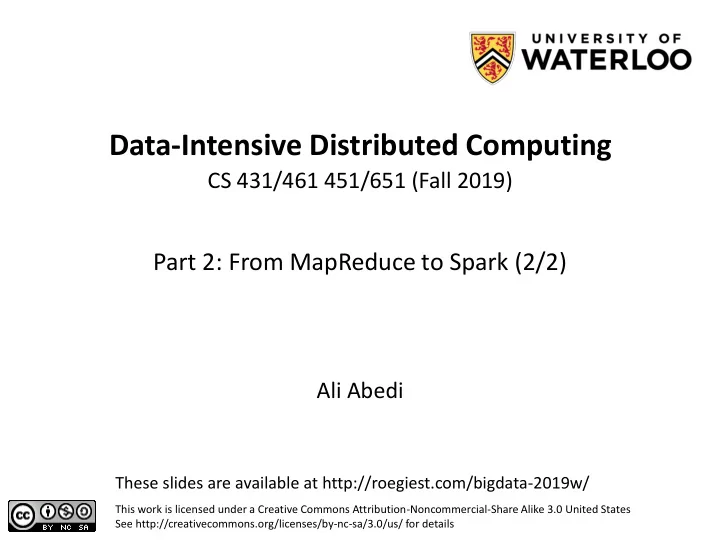

Data-Intensive Distributed Computing CS 431/461 451/651 (Fall 2019) Part 2: From MapReduce to Spark (2/2) Ali Abedi These slides are available at http://roegiest.com/bigdata-2019w/ This work is licensed under a Creative Commons Attribution-Noncommercial-Share Alike 3.0 United States See http://creativecommons.org/licenses/by-nc-sa/3.0/us/ for details
YARN Hadoop’s (original) limitations: Can only run MapReduce What if we want to run other distributed frameworks? YARN = Yet-Another-Resource-Negotiator Provides API to develop any generic distributed application Handles scheduling and resource request MapReduce (MR2) is one such application in YARN
Hadoop MapReduce Architecture namenode (NN) jobtracker (JT) namenode daemon jobtracker daemon tasktracker daemon tasktracker daemon tasktracker daemon datanode daemon datanode daemon datanode daemon Linux file system Linux file system Linux file system … … … worker node worker node worker node Hadoop v1.0
Hadoop v1.0
Hadoop v2.0
Spark Architecture
Algorithm Design
Closure Takes type X and returns type X • 3 + 4 = 7 (int + int = int) • 5 / 2 = 2.5 (int + int != float)
Identity “concept of nothing” • 5 + 0 = 5 • 5 * 1 = 5 • {3, 11, 9} + {} = {3, 11, 9} • Initializing a counter to zero
Associativity Add parenthesis anywhere • 1 + 2 + 3 = (1 + 2) + 3 • 10 / 2 / 5 != 10 / (2 / 5) • Huge jobs can become many small jobs
Commutativity Reordering • 1 + 2 + 3 = 2 + 3 + 1 • 10 / 2 != 2 /10
Monoid • Closure (int + int = int) • Identity (1 + 0 = 1) • Associativity (1 + 2 + 3 = (1 + 2) + 3) • Commutative Monoid
Commutative Monoid and MapReduce ( ) ( ) ( ) 1 + 1 + 1 + 1 + 1 + 1 + 1 + 1 + 1 + 1 + 1 + 1 + 1 + 1 3 7 4 7 4 3 14
Two superpowers: Associativity Commutativity (sorting)
Implications for distributed processing? You don’t know when the tasks begin You don’t know when the tasks end You don’t know when the tasks interrupt each other You don’t know when intermediate data arrive …
Word Count: Baseline class Mapper { def map(key: Long, value: String) = { for (word <- tokenize(value)) { emit(word, 1) } } } class Reducer { def reduce(key: String, values: Iterable[Int]) = { for (value <- values) { sum += value } emit(key, sum) } }
Computing the Mean: Version 1 class Mapper { def map(key: String, value: Int) = { emit(key, value) } } class Reducer { def reduce(key: String, values: Iterable[Int]) { for (value <- values) { sum += value cnt += 1 } emit(key, sum/cnt) } }
Computing the Mean: Version 3 class Mapper { def map(key: String, value: Int) = emit(key, (value, 1)) } class Combiner { def reduce(key: String, values: Iterable[Pair]) = { for ((s, c) <- values) { sum += s cnt += c } emit(key, (sum, cnt)) } } class Reducer { def reduce(key: String, values: Iterable[Pair]) = { for ((s, c) <- values) { sum += s cnt += c } emit(key, sum/cnt) } }
Co-occurrence Matrix: Stripes class Mapper { def map(key: Long, value: String) = { for (u <- tokenize(value)) { val map = new Map() for (v <- neighbors(u)) { map(v) += 1 } emit(u, map) } } } class Reducer { def reduce(key: String, values: Iterable[Map]) = { val map = new Map() for (value <- values) { map += value } emit(key, map) } }
Synchronization: Pairs vs. Stripes Approach 1: turn synchronization into an ordering problem Sort keys into correct order of computation Partition key space so each reducer receives appropriate set of partial results Hold state in reducer across multiple key-value pairs to perform computation Illustrated by the “pairs” approach Approach 2: data structures that bring partial results together Each reducer receives all the data it needs to complete the computation Illustrated by the “stripes” approach
Because you can’t avoid this… … … But commutative monoids help
Synchronization: Pairs vs. Stripes Approach 1: turn synchronization into an ordering problem Sort keys into correct order of computation Partition key space so each reducer receives appropriate set of partial results Hold state in reducer across multiple key-value pairs to perform computation Illustrated by the “pairs” approach Approach 2: data structures that bring partial results together Each reducer receives all the data it needs to complete the computation Illustrated by the “stripes” approach
f (B|A): “ Pairs ” (a, *) → 32 Reducer holds this value in memory (a, b 1 ) → 3 (a, b 1 ) → 3 / 32 (a, b 2 ) → 12 (a, b 2 ) → 12 / 32 (a, b 3 ) → 7 (a, b 3 ) → 7 / 32 (a, b 4 ) → 1 (a, b 4 ) → 1 / 32 … … For this to work: Emit extra (a, *) for every b n in mapper Make sure all a’s get sent to same reducer (use partitioner) Make sure (a, *) comes first (define sort order) Hold state in reducer across different key-value pairs
Two superpowers: Associativity Commutativity (sorting)
When you can’t “ monoidify ” … … Sequence your computations by sorting
Algorithm design in a nutshell… Exploit associativity and commutativity via commutative monoids (if you can) Exploit framework-based sorting to sequence computations (if you can’t) Source: Wikipedia (Walnut)
Recommend
More recommend